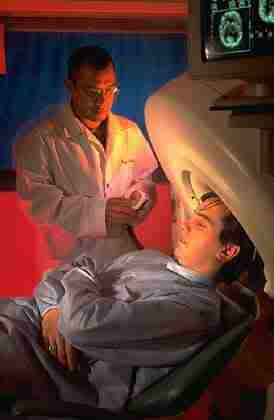Adipose Tissue Concentrations of Persistent Organic Pollutants and the Risk of Prostate Cancer.
Prostate cancer is the most common malignancy in Western society. In Sweden, 9030 men were diagnosed in 2003, and the lifetime risk of being diagnosed with prostate cancer is 16%. During the last 10-year time period, the age-standardized incidence increased by 4% annually, mainly because of increased prostate specific antigen (PSA) testing. However, a real increase in incidence, as the result of unrevealed exposures, cannot be excluded.
The etiology of prostate cancer is poorly understood. Besides age, family history, and ethnicity, there are no established risk factors. An increased risk has been associated with use of pesticides and higher incidence and mortality has been found among farmers.
Few studies have investigated an association between persistent organic pollutants (POPs) and prostate cancer. In one study, the serum concentration of polychlorinated biphenyl (PCB) was positively associated with the risk of prostate cancer. Indeed, in a further analysis, it was found that the odds ratio (OR) more than doubled among men with the highest concentration of moderately chlorinated PCBs in comparison with the lowest concentrations.
POPs such as PCBs are fat-soluble chemicals that bioaccumulate in the human body. An increased risk for non-Hodgkin lymphoma has been indicated for PCBs, possibly mediated by immunotoxic effects. Several POPs are endocrine disrupters, exerting estrogen and androgen activity with adverse effects on male reproduction. The estrogenic and androgenic activity may act both as agonist or as an antagonist. Sex steroid hormones are required for normal growth and function of the prostate. It also has been proposed that they may be involved in development of prostate cancer. Moreover, prostate cancer mostly responds to hormonal manipulation. As POPs exert endocrine effects it seems reasonable to investigate their association with prostate cancer. The aim of this study was to compare the adipose tissue concentrations of POPs in patients with a newly diagnosed prostate cancer and hospital based controls undergoing transuretral resection for benign prostate hyperplasia.
Discussion
Our main finding in this study was an association between certain persistent organic pollutants and prostate cancer, significantly so for PCB 153 and trans-chlordane in the total study population. PCB 153 is the congener with the highest concentration of all PCB congeners. Thus, PCB 153 may be used as a marker for PCB exposure. For most of the studied POPs, OR increased further in the case group with PSA greater than 16.5 ng/mL. However, it must be pointed out that the results are suggestive for an association given the broad CIs and the arbitrary cut-off point of PSA.
Prostate cancer is the most common cancer type among men in the Western world. The etiology is largely unknown. The incidence of prostate cancer has increased substantially since 1997, mainly because of increased PSA testing. The mean age at diagnosis in Sweden is 73 years, which is in agreement with the mean age in our study.
Prostate cancer is hormonally related, and PCB congeners may act with estrogenic, antiestrogenic, and dioxin-like effects based on level of chlorination and molecular configuration. We grouped PCB congeners based on proposed biological activity.
Grouping of PCBs according to Wolff et al gave highest OR for enzyme-inducing PCBs, which is in agreement with the results of Ritchie et al. In that study, increased ORs also were presented for moderately chlorinated PCBs grouped according to Moysich et al. We found increased OR for both lower and moderately chlorinated PCBs. Grouping of PCBs based on McFarland and Clarke showed highest OR for phenobarbital inducers, which is similar to results by Ritchie et al. It should be noted that in a recent study on mice exposure to estrogen in the neonatal period affected prostate growth and gave an increased incidence of prostate intraepithelial lesion in late life.
Endocrine disrupting properties also have been shown for hexachlorobenzene, p,p’-DDE, and chlordanes, as we have discussed elsewhere. We also found increased ORs for these POPs. All results were lipid based, and adjustments were made for BMI. The sum of PBDEs was not increased or affected by PSA level, and this fact also argues against disease bias.
The mechanism for POPs as potential risk factors for prostate cancer is unclear. Because they are endocrine disruptors, hormonal activity may be involved in late-stage carcinogenesis. Of course, this hypothesis should be further studied, both in epidemiological and laboratory investigations. Family history is one risk factor for prostate cancer. Three cases and two controls reported at least one first-degree relative with prostate cancer. Adjustment for heredity was made in one analysis, but the results were not statistically significant (data not shown). Few cases had a family history of prostate cancer, probably because of random variation.
The Gleason grading system offers valuable prognostic information, and the probability of developing metastasis has been found to increase with increasing Gleason score. Thus, the risk estimates would be expected to increase by more aggressive tumors. However, the risk estimates were not changed by tumor stage or Gleason score in multivariate analyses. This might be the result of the small study number, which provided insufficient power to detect a true difference. We also analyzed risk according to PSA with a cut-off at 16.5 ng/mL and found greater ORs for the different POPs, except for cis-heptachlorepoxide and the sum of PBDEs, in the case group with PSAs greater than 16.5 ng/mL than in the group with PSAs 16.5 ng/mL or less. Clinically, it is unclear what this PSA cut-off value implies, besides the median value among the cases. The PSA level is correlated with tumor burden. However, a PSA value greater than 16.5 ng/mL is not considered equivalent with advanced tumor stage, and we have no obvious explanation for this finding. We also grouped cases according to PSA levels of more biological relevance. The results were similar in the case group with highest PSA (more than 10 ng/mL) as in the group with PSA level greater than 16.5 ng/mL.
In this study, the concentration of most of the analyzed POPs was somewhat higher in the cases than in the controls. No subject reported occupational exposure to the studied chemicals. One possibility for the higher concentration in the cases might be weight loss because of the disease. However, mean BMI in the cases (25.54) was not significantly different from the controls (26.33). We analyzed also BMI in the cases 1 year before diagnosis, ie, time of adipose tissue sampling, (BMI = 25.78) and found no significant difference with the current index (BMI = 25.54). Thus, it is unlikely that the results were explained by weight loss among the cases. Furthermore, we divided the cases in two groups based on median PSA level. In the group of cases with PSAs 16.5 ng/mL or less, mean BMI at diagnosis was 26.18 and 1 year before diagnosis 26.41. For cases with PSAs greater than 16,5 ng/mL, the results were 24.90 and 25.15, respectively. It is thus unlikely that the results regarding concentrations of POPs were explained by loss of weight among the cases.
Some methodological limitations of this study have to be considered, and the results must be interpreted with caution. First, the number of cases and controls is low and, thus, the power of the study is limited. Second, there is an imbalance regarding the number of cases and controls, with only 20 subjects turning out to have a benign prostate hyperplasia. Thus, this low number of controls did not permit grouping of the concentrations of POPs in quartiles. In one analysis, we categorized certain organochlorines in tertiles without considering PSA level.
Furthermore, some difficulties may arise by the selection of patients with benign hyperplasia as controls if common risk factors exist both for prostate cancer and benign hyperplasia, which would bias the results toward unity. On the other hand, the controls constitute a reasonable homogenous group with histopathological confirmation of benign prostate hyperplasia and are similar in many aspects with prostate cancer patients, for instance, age distribution. This is valid at least for the recruiting time period (1997–1999), where no screening activity for prostate cancer took place.
This study has also some strengths; the population-based design and the high response rate among both cases and controls. All adipose tissue samples got an id number, and it was not disclosed until statistical analysis if it was a case or a control. It is thus unlikely that the results were influenced by observational bias.
In conclusion, this study provided indications that prostate cancer may be related to certain persistent organic pollutants. It should be noted, however, that the results in this study were based on low numbers, especially for the controls, and the findings must be interpreted with caution. Certainly, these results stimulate to further research on this topic.
Conclusions:
These chemicals might be of etiologic significance but need to be further investigated. The biological relevance of the arbitrary cut-off point of PSA is unclear.




1 Comments:
I want not acquiesce in on it. I regard as warm-hearted post. Particularly the title-deed attracted me to read the whole story.
Post a Comment
<< Home